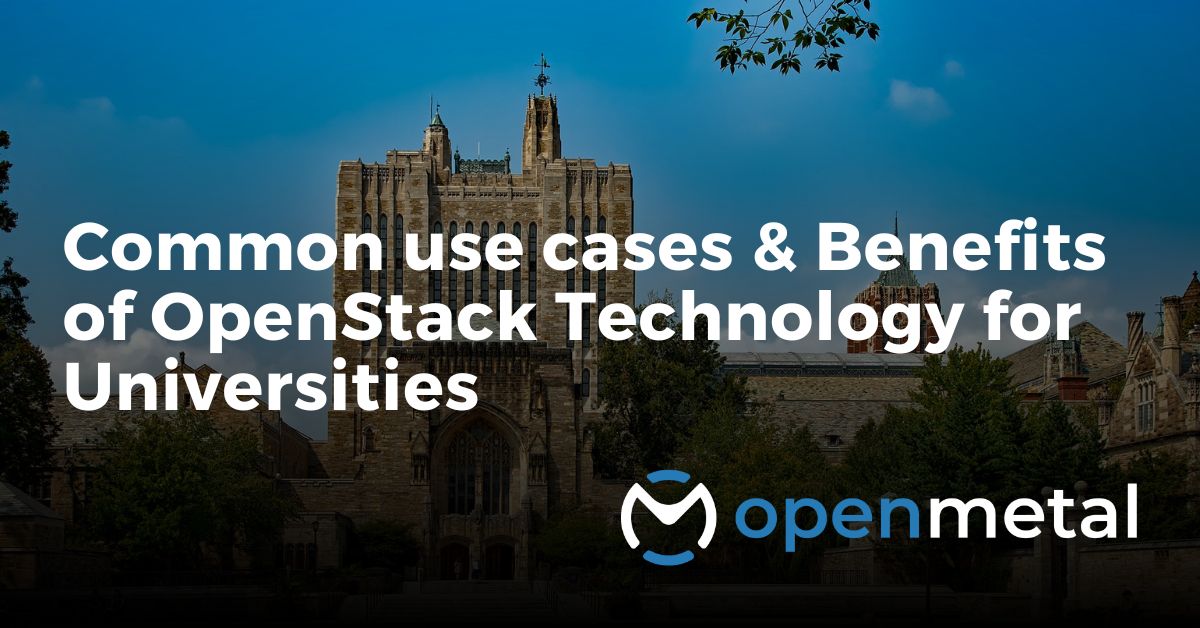Based on OpenMetal’s experience working with higher learning organizations and direct independent market research, our team has found many universities and education institutions are using open-source technologies like OpenStack to achieve its IT objectives. In this blog post, we will explore the utilization of OpenStack by universities, delving into its advantages for these educational institutions. We’ll also provide guidance on how to start your journey with OpenStack.
Here are five of the most common use cases of how universities use OpenStack:
- Virtualizing research environments: OpenStack cloud can be used to create virtualized research environments for faculty and students. This allows researchers to share resources and collaborate on projects more easily.
- Delivering online learning courses: OpenStack cloud can be used to deliver online learning courses. This allows universities to reach a wider audience with their educational offerings.
- Managing IT infrastructure: OpenStack cloud can be used to manage a university’s IT infrastructure. This can help universities to reduce their IT costs and improve their IT agility.
- Providing cloud computing services to students and faculty: OpenStack cloud can be used to provide cloud computing services to students and faculty. This allows students and faculty to access computing resources on demand, which can be helpful for research, teaching, and other activities.
- Hosting research applications: OpenStack cloud can be used to host research applications. This allows researchers to deploy and manage their applications in a scalable and cost-effective way.
Open-source and OpenStack cloud technology offer a number of benefits for universities and other high education institutions. These benefits include:
- Cost savings: Open-source software is typically free or very low cost, which can save universities a significant amount of money on IT infrastructure costs.
- Flexibility: Open-source cloud technology is highly flexible, which allows universities to customize it to meet their specific needs. This can be especially beneficial for universities that need to support a wide range of research and teaching activities.
- Scalability: Open-source cloud technology is highly scalable, which allows universities to easily add or remove resources as needed. When managing educational content such as math worksheets, cloud scalability ensures smooth access and distribution for students and educators alike. This can help universities to avoid over-provisioning their IT infrastructure, which can save them money in the long run.
- Security: Open-source cloud technology is generally considered to be very secure. This is because the code is open for inspection by anyone, which makes it difficult for hackers to exploit vulnerabilities.
- Community support: There is a large and active community of OpenStack users and developers, which provides universities with a wealth of resources and support. This can be helpful for universities that are new to OpenStack or that need help with troubleshooting or customization.
Overall, open-source and OpenStack cloud technology offer a number of benefits for universities and other high education institutions. These benefits can help universities to save money, improve their teaching and research capabilities, and stay ahead of the curve in terms of IT innovation.
Here are some specific examples of how universities are using OpenStack cloud technology:
- University of California, Berkeley: The University of California, Berkeley, has a private OpenStack cloud with over 5,000 compute cores and 50TB of storage.
- University of Cambridge: The University of Cambridge has a private OpenStack cloud with over 2,000 compute cores and 20TB of storage.
- University of Melbourne: The University of Melbourne has a private OpenStack cloud with over 1,000 compute cores and 10TB of storage.
- University of Pittsburgh: The University of Pittsburgh has a private OpenStack cloud with over 500 compute cores and 5TB of storage.
- University of Toronto: The University of Toronto has a private OpenStack cloud with over 200 compute cores and 2TB of storage.
Here is an excellent case study of the University of Edinburgh deploying OpenStack and Ceph to lower their TCO (Total Cost of Ownership):
- The University of Edinburgh: The University of Edinburgh decided in early 2016 to implement OpenStack-based private cloud, to be able to provide the University’s researchers with more flexible self-served computing services. The University would like to build the solution on an advanced, flexible and cost effective platform based on open source technologies.
The OpenStack-based cloud includes a Ceph storage system designed to deliver high performance and reliability while balancing optimal cost and delivery timelines, with a balanced configuration of SSD and NL SATA drives set up for 3x replication. With distributed virtual routers (DVR), OpenStack networking was designed to achieve high performance with optimal cost and balancing of bottlenecks. All the management services operate in highly available (HA) mode, to the extent that entire racks of management servers can be turned off without impacting the private cloud service, thus ensuring service uptime. The solution design allowed the University to achieve service-assuring Zero-Downtime Upgrade with FishOS Upgrader. The system commenced with FishOS Starter, allowing subsequent upgrade to FishOS White.
Here is a link for the full details on the University of Edinburgh case study.
These are just a few examples of how universities are using OpenStack cloud technology to maximize their IT budget and achieve more from their technology investment. As the technology continues to evolve, we can expect to see even more innovative uses of OpenStack in higher education.
To start a free private cloud OpenStack on-demand PoC project for your higher education institution, sign up here.
More on the OpenMetal Blog…

Comparing Deployment Methods for Kubernetes on OpenStack.
This blog post discusses different deployment methods for running Kubernetes on OpenStack, including Kubespray, Rancher, Portainer, and Kubeadm. It provides an overview of each method, their pros and cons, and guidance on choosing the right approach for your …Read More

It may be surprising to see large scale OpenStack use cases such as Walmart or China Mobile, or use cases in organizations like NASA who have stringent security regulations, but the ability of organizations to fine tune and customize OpenStack in the code makes it the ideal infrastructure software for …Read More

OpenStack Tutorial For Beginners.
This blog introduces OpenStack, an open-source cloud computing infrastructure software known for its scalability, reliability, and control over infrastructure. It addresses the common hesitations around OpenStack’s complexity and provides an overview of a tutorial created by FreeCodeCamp, … Read More
Test Drive
For eligible organizations, individuals, and Open Source Partners, Private Cloud Cores are free to trial. Apply today to qualify.
Subscribe
Join our community! Subscribe to our newsletter to get the latest company news, product releases, updates from partners, and more.



































